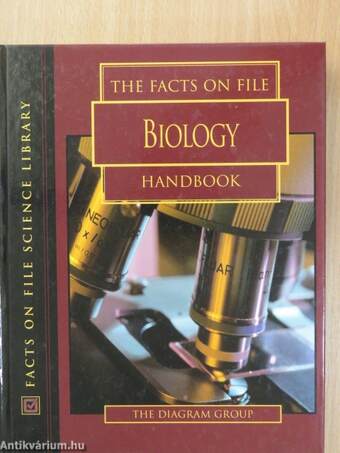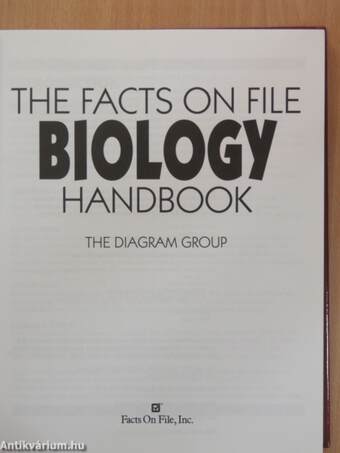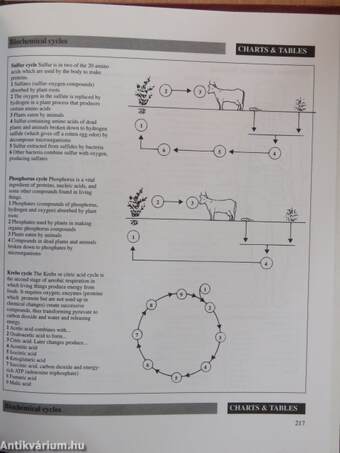1.117.303
kiadvánnyal nyújtjuk Magyarország legnagyobb antikvár könyv-kínálatát
The Facts on File Biology Handbook
The Diagram Group
| Kiadó: | Facts on File, Inc. |
|---|---|
| Kiadás helye: | New York |
| Kiadás éve: | |
| Kötés típusa: | Fűzött kemény papírkötés |
| Oldalszám: | 223 oldal |
| Sorozatcím: | Facts on File Science Library |
| Kötetszám: | |
| Nyelv: | Angol |
| Méret: | 24 cm x 19 cm |
| ISBN: | 0-8160-4079-6 |
| Megjegyzés: | Fekete-fehér illusztrációkkal, ábrákkal. |
naponta értesítjük a beérkező friss
kiadványokról
naponta értesítjük a beérkező friss
kiadványokról
Fülszöveg
BiologyHANDBOOK
How are miles converted into kilometers? When did Joseph Priestley discover oxygen? What is an isomer? What are the largest lakes and the longest rivers? It is becoming increasingly difficult for students to get quick, direct answers to basic science questions. With time for researching and writing often tight, students will welcome
The Facts On File Science Handbooks, a new reference series covering the subjects of chemistry, Earth science, physics, and biology.
The Facts On File Biology Handbook features the following components:
¦ A glossary of more than 1,000 entries, many accompanied by labeled diagrams to help clarify the meanings. Topics covered include adrenal gland, amniocentesis, botany, cell membrane, embryo, hormone, lymph node, synthesis, ventricle, and zygote
¦ Biographies of more than 400 scientists from ancient times to the present whose discoveries have pushed forward the world's understanding and appreciation of biology. Scientists discussed... Tovább
Fülszöveg
BiologyHANDBOOK
How are miles converted into kilometers? When did Joseph Priestley discover oxygen? What is an isomer? What are the largest lakes and the longest rivers? It is becoming increasingly difficult for students to get quick, direct answers to basic science questions. With time for researching and writing often tight, students will welcome
The Facts On File Science Handbooks, a new reference series covering the subjects of chemistry, Earth science, physics, and biology.
The Facts On File Biology Handbook features the following components:
¦ A glossary of more than 1,000 entries, many accompanied by labeled diagrams to help clarify the meanings. Topics covered include adrenal gland, amniocentesis, botany, cell membrane, embryo, hormone, lymph node, synthesis, ventricle, and zygote
¦ Biographies of more than 400 scientists from ancient times to the present whose discoveries have pushed forward the world's understanding and appreciation of biology. Scientists discussed include Elizabeth Garrett Anderson, John James Audubon, Francis Bacon, Jacques-Yves Cousteau, Hippocrates, Edwin Powell Hubble, Linus Pauling, Jonas Edward Salk, and Frederick Sanger
¦ A chronology that tracks the dates of significant developments and discoveries from ancient Greece to the present day. Events noted include the first recorded dissection of a human corpse for scientific purposes carried out by Greek physician Alcmaeon (c. 491 bce); Greek philosopher Aristotle's classification of 500 species of animals into eight classes and his dissection of many species (350-341 bce ; Italian astronomer and physicist Galileo Galilei's study of insect anatomy with a microscope he designed and built (c. 1610); and French chemist Louis Pasteur's discovery of anaerobic organisms (1876)
¦ Tables, charts, and diagrams
¦ Measurements, formulas, and calculations
Supplemented by a helpful index, this book and the other volumes in The Facts On File Science Handbook series will enable students to compare information across subject areas, place each subject in context, and underline the close connections between all the sciences. Vissza
Témakörök
- Idegennyelv > Idegennyelvű könyvek > Angol > Természettudományok > Biológia
- Természettudomány > Biológia > Biológia, általános > Kézikönyv, lexikon
- Természettudomány > Biológia > Biológia, általános > Általában
- Természettudomány > Biológia > Biológia, általános > Tudósok
- Természettudomány > Biológia > Biológia, általános > Idegennyelvű
Megvásárolható példányok
Nincs megvásárolható példány
A könyv összes megrendelhető példánya elfogyott. Ha kívánja, előjegyezheti a könyvet, és amint a könyv egy újabb példánya elérhető lesz, értesítjük.










